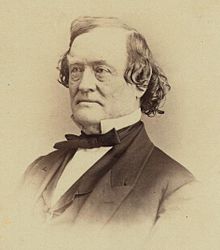Rufus Paine Spalding
| Rufus P. Spalding | |
|---|---|
 |
|
| Member of the U.S. House of Representatives from Ohio's 18th district |
|
|
In office March 4, 1863 – March 3, 1869 |
|
| Preceded by | Sidney Edgerton |
| Succeeded by | William H. Upson |
| Justice of the Ohio Supreme Court | |
|
In office February 20, 1849 – February 9, 1852 |
|
| Preceded by | Nathaniel C. Reed |
| Succeeded by | Thomas Welles Bartley |
| Member of the Ohio House of Representatives | |
|
In office 1839-1842 |
|
| Personal details | |
| Born |
Rufus Paine Spalding May 3, 1798 West Tisbury, Massachusetts, USA |
| Died | August 29, 1886 (aged 88) Cleveland, Ohio, USA |
| Resting place | Lake View Cemetery |
| Political party | |
| Spouse(s) | Nancy Spalding |
| Profession | Politician, Lawyer, Judge |
Rufus Paine Spalding (May 3, 1798 – August 29, 1886) was a nineteenth-century politician, lawyer and judge from Ohio.
Born in West Tisbury, Massachusetts, Spalding graduated from Yale College in 1817. After graduating, Spalding began his study of law as an apprentice under Zephaniah Swift. Swift was a prominent lawyer and judge from Connecticut, and the author of several legal "digests." During his apprenticeship, Swift was the sitting Chief Justice of the Connecticut Supreme Court. In December 1819, Spalding left New England and moved to Little Rock, Arkansas. In Little Rock, Spalding established a law practice with Samuel Dinsmoore. Spalding and Dismoore practiced law together for a year and a half before Spalding dissolved the partnership and left the state. In 1821 Spalding moved to Warren, Ohio to continue practicing. He moved to Ravenna, Ohio in 1835 and, once again, commenced the practice of law.
In 1839, Spalding was elected to the Ohio House of Representatives as a Democrat. During his first term, Spalding's most notable accomplishment was overseeing the creation of Summit County, Ohio. Lawmakers in the General Assembly had proposed legislation to form a new county six years before Spalding was elected, but the bill failed to gain the necessary support. Under the proposed plan, land from the western townships of Portage County, eastern townships of Medina County, and northern townships of Stark County was to be taken in order to create the new county. Republican Representatives from these counties opposed the legislation for political reasons. Following the 1839 election, the Democrats, led by Spalding, and the Whigs gained enough seats to form a coalition and pass bill. Following the creation of Summit County, Spalding moved from Ravenna to Akron, Ohio.
Spalding was reelected to the Ohio House of Representatives in 1841, and served as Speaker of the House for one term. During his second term, Spalding oversaw the defeat of a bill which would have repudiated the state debt. During the 1840s Ohio suffered from an inflationary boom. As a result, the state now faced repayment of the debt with dollars that were worth more than the money they had been previously borrowed. A popular solution at the time was to repudiate the debt. Spalding opposed the idea. He believed that if Ohio repudiated its debt and chose not to repay its creditors, it would make it harder for the state to borrow money in the future. Proponents of the debt repudiation bill continued to push for its passage. It was not until John Brough, the State Auditor, joined Spalding in opposing the scheme, that the bill died.
...
Wikipedia
